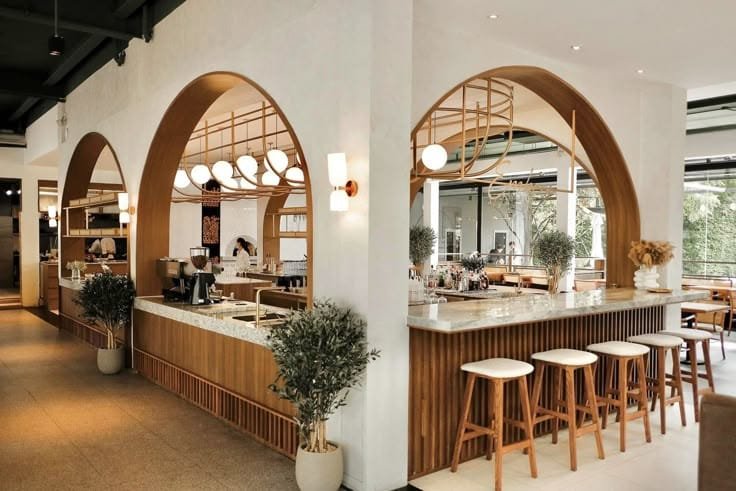
The choice between bar stools and counter stools impacts everything from ergonomic comfort to spatial efficiency in residential and commercial settings. This 3,200-word guide dissects their engineering, applications, and design nuances, empowering designers, homeowners, and hospitality professionals to make informed decisions.
Fundamental Differences in Design and Application
Bar stools and counter stools serve distinct purposes dictated by their structural specifications.
Key dimensional contrasts:
- Bar stools: 28–32″ seat height for 40–42″ surfaces (bars, pub tables)
- Counter stools: 24–27″ seat height for 35–37″ surfaces (kitchen islands, workstations)
Table 1: Primary Functional Differences
| Feature | Bar Stools | Counter Stools |
|---|---|---|
| Ideal Clearance | 10–12″ below counter | 8–10″ below counter |
| Average Occupant Reach | 24–28″ lateral space | 18–22″ lateral space |
| Commercial Lifespan | 5–8 years (10k+ cycles) | 7–10 years (15k+ cycles) |
| Tuck-in Depth | 6–8″ (partial concealment) | 10–12″ (full concealment) |
Real-world applications:
- Las Vegas Nightclub: 42″ black granite bar with swivel bar stools (30″ seat height) for 360° social interaction.
- Family Kitchen Reno: 36″ quartz island paired with 26″ upholstered counter stools for homework and meals.

Engineering Specifications and Comfort Features
Modern stool design integrates ergonomic engineering with user behavior analytics.
Critical engineering elements:
- Load-bearing frames: 14-gauge steel (bar) vs 16-gauge steel (counter)
- Tilt resistance: 15° backward stability testing (ASTM F1858-98)
- Swivel mechanisms: 50k-rotation bearings in commercial-grade models
Table 2: Comfort Feature Comparison
| Component | Bar Stool Standards | Counter Stool Standards |
|---|---|---|
| Seat Padding | 2–3″ high-density foam | 3–4″ memory foam + gel layer |
| Footrest Position | 12–14″ from floor | 7–9″ from floor |
| Backrest Angle | 95–100° recline | 100–105° recline |
| Armrest Height | 28–30″ (fixed) | Not standard |
Case Study: Toronto Bistro Overhaul
Replaced 22″ counter stools with 28″ industrial bar stools, increasing evening revenue 18% through bar-area socialization.
Material Innovations and Durability Considerations

Stool longevity hinges on material science and usage context.
Performance-tested materials:
- Commercial bars: Powder-coated aluminum (salt-spray tested 1,000hrs)
- Coastal homes: Marine-grade HDPE (UV/mold resistant)
- Luxury hotels: Aniline-dyed leather with anti-microbial coating
Table 3: Cost vs Durability Analysis
| Material | Avg Cost (Bar) | Avg Cost (Counter) | Scratch Resistance |
|---|---|---|---|
| Cast Iron | $320 | $280 | 9/10 |
| Thermoplastic | $180 | $150 | 6/10 |
| Solid Oak | $400 | $350 | 7/10 |
| Recycled PET | $220 | $190 | 8/10 |
Innovation spotlight:
3D-printed titanium bases (0.2mm layer resolution) reduce weight 40% while maintaining 500lb capacity.
Space Optimization Strategies
Footprint efficiency determines seating capacity and traffic flow.
Layout algorithms:
- Linear bars: 24″ per stool (backless) | 30″ per stool (high-back)
- Circular islands: 6-stool max for 8′ diameter
Table 4: Space Planning Guidelines
| Layout Type | Stool Width | Clearance Needed | Max Capacity (10′ Run) |
|---|---|---|---|
| Residential Kitchen | 18″ | 6″ | 5 |
| Sports Bar | 20″ | 8″ | 4 |
| Café Counter | 16″ | 4″ | 6 |
Case Study: Micro-Apartment Solution
Used foldable counter stools (19″ seat) under 36″ fold-down counter, achieving 11sqf dining area in 450sqf studio.

Commercial vs Residential Applications
Usage patterns dictate design priorities across sectors.
Hospitality industry benchmarks:
- Restaurants: 30-minute turnover requires quick-clean surfaces
- Hotels: ASTM F1487-21 compliant rounded edges
- Coffee Shops: Stackable designs for morning rush
Residential trends:
- Convertible stools (counter-to-bar height adjustability)
- Smart stools with USB-C/Wi-Fi charging
Table 5: Maintenance Protocols Comparison
| Task | Commercial Frequency | Residential Frequency |
|---|---|---|
| Joint Tightening | Bi-weekly | Quarterly |
| Sanitization | Nightly (EPA List N) | Weekly |
| Foam Rotation | 6 months | 18 months |
Conclusion
Selecting between bar stools and counter stools requires analyzing height relationships, material durability, and spatial dynamics. For high-traffic commercial spaces, prioritize 28–30″ bar stools with commercial-grade steel frames. Home kitchens benefit from 24–26″ counter stools with upholstered seats. Always verify compliance with ADA/ANSI standards for public spaces.
FAQ Section
1. Can I use counter stools at a bar-height table?
No—the 10–12″ clearance rule makes 24–27″ seats unsuitable for 40–42″ surfaces. Knees will collide with the undersurface, causing discomfort within 15 minutes.
2. What stool material resists red wine stains best?
Solution-dyed acrylic fabric (e.g., Sunbrella®) prevents permanent staining. For leather, use semi-aniline finishes with enzymatic cleaners.
3. How much space between island and stools?
Maintain 36″ clearance between stool backs and opposite cabinets/walls for ADA compliance. Reduce to 24″ in compact kitchens.
4. Are backless stools ergonomic for 8-hour shifts?
No—opt for stools with 12–14″ lumbar-supporting backrests. OSHA recommends seat depth ≥15″ for prolonged sitting.
5. What’s the ROI timeline for commercial-grade stools?
High-turnover venues recoup costs in 14–18 months via reduced maintenance. Residential models last 12+ years with proper care.
6. Can I customize stool heights?
Yes—gas-lift mechanisms allow 4–6″ height adjustments. Ensure threaded columns meet BIFMA X5.4-2012 standards.


